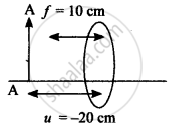Advertisements
Advertisements
प्रश्न
An object is placed at a distance 20cm from a convex lens of focal length 10cm. Find the image distance and nature of the image.
उत्तर
u = -20 cm
f = 10 cm
`1/"f"` = `1/"v"`- `1/"u"`
`1/"v"` = `1/"f"`+ `1/"u"`
`1/"v"`= `1/10`+`1/"(-120)"`
`1/"v"`=`1/10`- `1/20`
v = `1/20` ⇒ v = 20 cm

Nature of the image real enlarged and inverted image.
APPEARS IN
संबंधित प्रश्न
A lens forms an upright and diminished image of an object when the object is placed at its focal point. Name the lens and draw a ray diagram to show the image formation.
A converging lens forms the image of an object placed in front of it beyond 2F2 of the lens. Where is the object placed?
Draw a ray diagram to show how a converging lens can form an image of the sun. Hence give a reason for the term ‘burning glass’ for a converging lens used in this manner.
A lens forms an inverted image of an object. What is the nature of the image real or virtual?
An object is placed at a distance 2f from a convex lens of focal length f. The size of the image formed is ______ that of the object.
For the object placed between the optical centre and focus of a convex lens, the image is ______.
Where should an object be placed so that a real and inverted image of the same size is obtained by a convex lens?
A small bulb is placed at the principal focus of a convex lens. When the bulb is switched on, the lens will produce
Explain the rules for obtaining images formed by a convex lens with the help of ray diagram.
An object of height 3cm is placed at 10cm from a concave lens of focal length 15cm. Find the size of the image.
